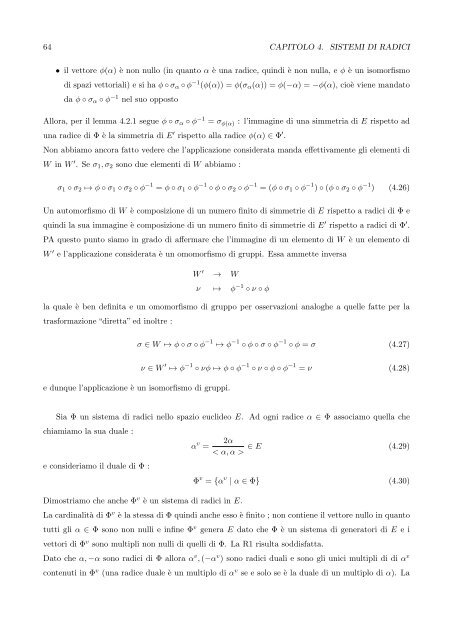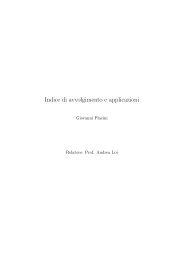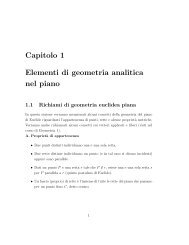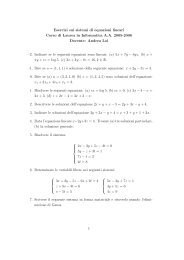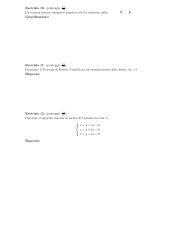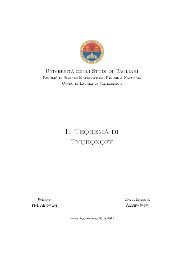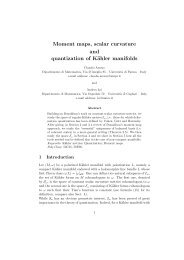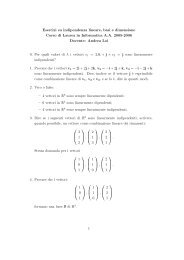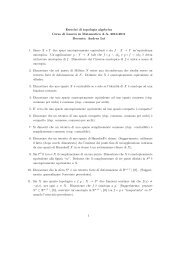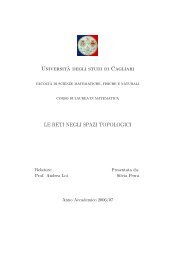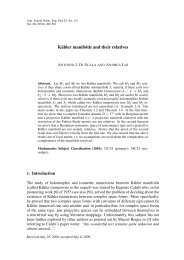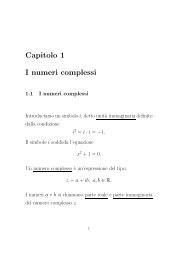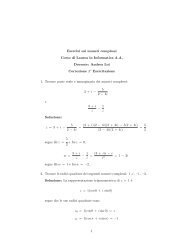Algebre di Lie semisemplici, sistemi di radici e loro classificazione
Algebre di Lie semisemplici, sistemi di radici e loro classificazione
Algebre di Lie semisemplici, sistemi di radici e loro classificazione
Create successful ePaper yourself
Turn your PDF publications into a flip-book with our unique Google optimized e-Paper software.
64 CAPITOLO 4. SISTEMI DI RADICI<br />
• il vettore φ(α) è non nullo (in quanto α è una ra<strong>di</strong>ce, quin<strong>di</strong> è non nulla, e φ è un isomorfismo<br />
<strong>di</strong> spazi vettoriali) e si ha φ ◦ σα ◦ φ −1 (φ(α)) = φ(σα(α)) = φ(−α) = −φ(α), cioè viene mandato<br />
da φ ◦ σα ◦ φ −1 nel suo opposto<br />
Allora, per il lemma 4.2.1 segue φ ◦ σα ◦ φ −1 = σ φ(α) : l’immagine <strong>di</strong> una simmetria <strong>di</strong> E rispetto ad<br />
una ra<strong>di</strong>ce <strong>di</strong> Φ è la simmetria <strong>di</strong> E ′ rispetto alla ra<strong>di</strong>ce φ(α) ∈ Φ ′ .<br />
Non abbiamo ancora fatto vedere che l’applicazione considerata manda effettivamente gli elementi <strong>di</strong><br />
W in W ′ . Se σ1, σ2 sono due elementi <strong>di</strong> W abbiamo :<br />
σ1 ◦ σ2 ↦→ φ ◦ σ1 ◦ σ2 ◦ φ −1 = φ ◦ σ1 ◦ φ −1 ◦ φ ◦ σ2 ◦ φ −1 = (φ ◦ σ1 ◦ φ −1 ) ◦ (φ ◦ σ2 ◦ φ −1 ) (4.26)<br />
Un automorfismo <strong>di</strong> W è composizione <strong>di</strong> un numero finito <strong>di</strong> simmetrie <strong>di</strong> E rispetto a ra<strong>di</strong>ci <strong>di</strong> Φ e<br />
quin<strong>di</strong> la sua immagine è composizione <strong>di</strong> un numero finito <strong>di</strong> simmetrie <strong>di</strong> E ′ rispetto a ra<strong>di</strong>ci <strong>di</strong> Φ ′ .<br />
PA questo punto siamo in grado <strong>di</strong> affermare che l’immagine <strong>di</strong> un elemento <strong>di</strong> W è un elemento <strong>di</strong><br />
W ′ e l’applicazione considerata è un omomorfismo <strong>di</strong> gruppi. Essa ammette inversa<br />
W ′ → W<br />
ν ↦→ φ −1 ◦ ν ◦ φ<br />
la quale è ben definita e un omomorfismo <strong>di</strong> gruppo per osservazioni analoghe a quelle fatte per la<br />
trasformazione “<strong>di</strong>retta” ed inoltre :<br />
e dunque l’applicazione è un isomorfismo <strong>di</strong> gruppi.<br />
σ ∈ W ↦→ φ ◦ σ ◦ φ −1 ↦→ φ −1 ◦ φ ◦ σ ◦ φ −1 ◦ φ = σ (4.27)<br />
ν ∈ W ′ ↦→ φ −1 ◦ νφ ↦→ φ ◦ φ −1 ◦ ν ◦ φ ◦ φ −1 = ν (4.28)<br />
Sia Φ un sistema <strong>di</strong> ra<strong>di</strong>ci nello spazio euclideo E. Ad ogni ra<strong>di</strong>ce α ∈ Φ associamo quella che<br />
chiamiamo la sua duale :<br />
e consideriamo il duale <strong>di</strong> Φ :<br />
α v =<br />
Dimostriamo che anche Φ v è un sistema <strong>di</strong> ra<strong>di</strong>ci in E.<br />
2α<br />
∈ E (4.29)<br />
< α, α ><br />
Φ v = {α v | α ∈ Φ} (4.30)<br />
La car<strong>di</strong>nalità <strong>di</strong> Φ v è la stessa <strong>di</strong> Φ quin<strong>di</strong> anche esso è finito ; non contiene il vettore nullo in quanto<br />
tutti gli α ∈ Φ sono non nulli e infine Φ v genera E dato che Φ è un sistema <strong>di</strong> generatori <strong>di</strong> E e i<br />
vettori <strong>di</strong> Φ v sono multipli non nulli <strong>di</strong> quelli <strong>di</strong> Φ. La R1 risulta sod<strong>di</strong>sfatta.<br />
Dato che α, −α sono ra<strong>di</strong>ci <strong>di</strong> Φ allora α v , (−α v ) sono ra<strong>di</strong>ci duali e sono gli unici multipli <strong>di</strong> <strong>di</strong> α v<br />
contenuti in Φ v (una ra<strong>di</strong>ce duale è un multiplo <strong>di</strong> α v se e solo se è la duale <strong>di</strong> un multiplo <strong>di</strong> α). La


